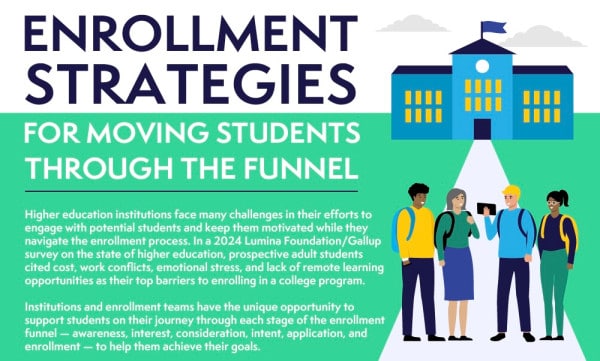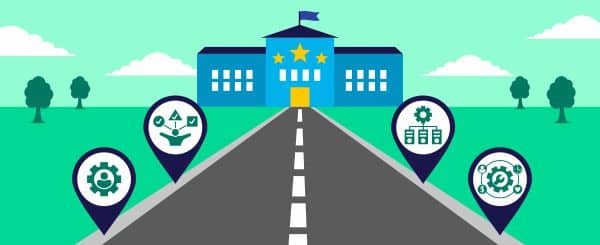Next Steps to Empower Your Multiyear Growth Road Map
In higher education organizations, enrollment management plans can be like the weather: short term, ever changing, and subject to the whims of the seasons each year.
But for your organization and programs to thrive no matter the conditions, a multiyear growth road map is needed to keep all parts of the organization aligned and moving toward a strategic set of goals.
In my last article, I discussed the importance of taking a step back to assess the people, processes, and technology of your organization to identify opportunities for improvement and high-quality growth. This critical first step results in an organizational development plan that moves your institution from good, to better, to best in class.
With this article, we’ll dig deeper to outline how you can build a multiyear growth road map that allows you to weather everything from regulatory storm clouds to enrollment droughts, keeping your focus on a longer-term strategy. You’ll learn how to get started, measure your progress, and ensure that feedback loops are in place for continuous improvement.
A multiyear growth road map helps your teams move beyond term-to-term thinking to develop activities that ladder up and contribute to a true organizational vision. Everyone has a part to play that is specific, measured, and celebrated.
The First 90 Days
As with any effective plan, laying a strong foundation can lead to long-term success. In the context of your multiyear strategic road map, building the foundation involves these steps:
- Hold discovery sessions: Engage with individuals and teams across your organization and open up space for productive — and sometimes uncomfortable — conversations. You are looking for concerns, challenges, and hopes for the future. This phase isn’t about problem-solving. It’s about understanding the existing culture and building trust.
- Complete an internal readiness assessment: This critical component looks at your institution’s existing strengths, weaknesses, and roadblocks. The readiness assessment process ensures that any proposed changes are offered within the context of your institution’s culture and helps you paint a realistic picture of what you’re ready to take on.
- Conduct a SWOT (strengths, weaknesses, opportunities, and threats) analysis: Once you have identified your internal current state, you can then compare that to the broader market and competitive landscape. Where is your organization or portfolio strongest, and where is it at greatest risk? Where are the potential market opportunities that you can begin to assess? Where are the most likely threats from competitors, regulation, resource shifts, or other market trends?
- Prepare for action: As the first 90 days close, you’ll have developed a much clearer image of a business case and action plan. This could mean starting with centralizing marketing efforts, for example, or it may involve planning for a technology tool or system and data mapping for eventual migration. Each institution is different.
Year One: The Blueprint
With a solid understanding of your institution’s current landscape — both internally and externally — it’s time to launch into the first year of your strategic road map. These 365 days are about implementing basic changes to boot up the structures, systems, and processes that will support growth in later years.
- Build your blueprint: Your blueprint is your North Star for change. It’s a clear vision that outlines your key goals, timelines, and measures of success. Think of it as a collection of SMART goals: specific, measurable, achievable, relevant, and time-bound.
- Take simple steps: This is where you implement the first round of changes, which should be relatively achievable. This could be adopting a new customer relationship management (CRM) system, refining a marketing strategy, or establishing new faculty support systems. The goal here is to get the basics right, then let these efforts evolve over time.
- Gather feedback: This may be the most important part of your first-year efforts: garnering input on the efficacy of the changes made from stakeholders from all levels and departments at your institution. Feedback loops help you gauge your progress and identify areas that need adjustments.
Year Two: Optimize and Accelerate
With a firm foundation now in place from your first year’s efforts, the focus shifts toward refinement, optimization, and acceleration of your growth initiatives. This phase is crucial, as it’s where you begin to see the fruits of your labor blossom.
- Double down on success: Now is the perfect time to capitalize on what’s working. Your teams are eager for a win, so identify any initiative that has shown promise — be it a marketing strategy that’s driving higher engagement or an educational program that’s exceeded enrollment expectations. By scaling these successful ventures, you can ride the momentum and amplify your results.
- Refine with data: Use the data accumulated from the initial implementations to tweak and improve your systems and processes. Engage in conversations with your teams to pinpoint any bottlenecks or slowdowns in the student journey. Experiment with new approaches based on these insights, and critically evaluate the impact of these changes. This iterative process is key to continuous improvement.
- Celebrate and share visible wins: Success is a powerful motivator. Make it a point to regularly share and celebrate each tangible achievement — whether it’s a surge in student enrollments, heightened faculty engagement, or the seamless adoption of a new process. Publicizing these wins not only builds internal momentum but also reinforces the collective commitment to your strategic goals.
Years Three and Four: Knowledge Sharing and Independence
As your strategic initiatives mature, the focus will naturally transition toward sharing knowledge and strengthening your internal teams. This critical period in years three and four is about empowering your staff and shifting your role from hands-on implementer to guiding coach.
- Empower through ownership: Encourage teams to take full ownership of the implemented processes and changes. This allows you to step back and adopt a coaching role, guiding your teams through challenges and ensuring they have the confidence and skills needed to manage and refine these new systems independently. This is also the time to ensure your organization has strong documentation on its processes and training both for knowledge sharing and to support future hiring and onboarding.
- Build internal capacity: Looking ahead and preparing for a future where your organization can operate and evolve without the need for external partnerships is essential. This requires a dedicated effort and a commitment to providing ongoing training, resources, and support to build a robust internal capacity. Invest in these areas to develop a self-sustaining system that thrives on its own merits.
- Celebrate the milestones: After your extensive efforts over the past few years, taking the time to celebrate is not just rewarding but necessary. Highlight the significant impacts made by your teams, and take a moment to reflect on the growth, changes, and obstacles that have been overcome. This celebration not only acknowledges the hard work but also reinforces your institution’s positive culture and its commitment to continuous improvement.
The Journey to Sustainable Development Starts Today
Successful organizational development requires a multiyear effort that encompasses careful planning, precise execution, and a dedicated team of leaders. From the initial 90 days to the subsequent years, each phase of the process moves your institution closer to becoming stronger and more agile.
Our team at Archer Education has helped dozens of institutions build and execute comprehensive multiyear strategic plans. These plans are tailored to enhance enrollment and retention, setting each institution on a path to long-term success.
If you’re ready to transform your organization and achieve remarkable results, reach out to us at Archer Education. Let’s make your educational vision a reality together.



